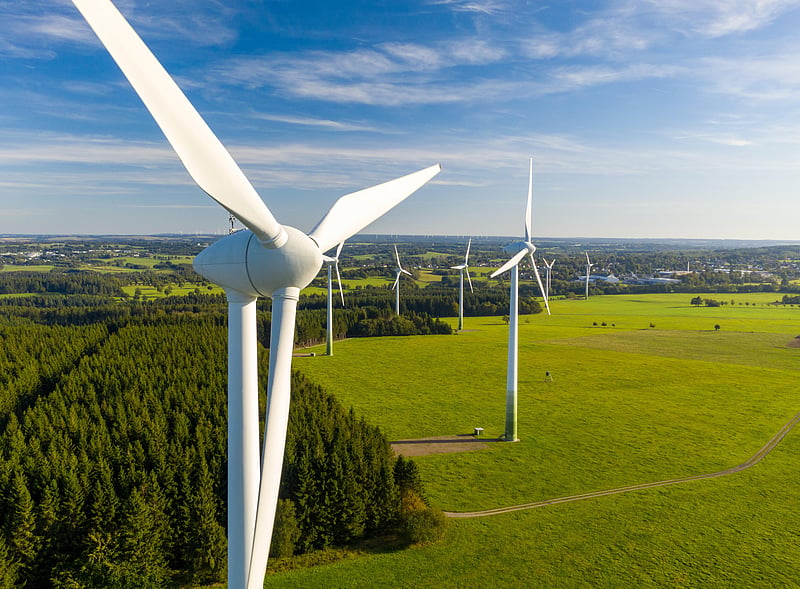Get Healthy!

- Alan Mozes
- Posted December 2, 2022
Wind Power Is Bringing Americans Real Health Benefits
With wind power picking up as a viable energy source, new research shows U.S. air quality is getting better, benefiting all Americans' health.
There was one caveat to the findings, however: Only about a third of the potentially enormous health benefit is being seen in low-income areas and those with a concentration of minority residents.
"Wind power has gained huge momentum in the U.S.," noted study author Noelle Selin, director of the technology and policy program at Massachusetts Institute of Technology's Institute for Data, Systems, and Society.
Nearly 10% of electricity nationwide is now generated by wind power, reducing greenhouse gas emissions that would otherwise be produced by power plants that rely on fossil fuels like coal and natural gas, she said.
In fact, wind power is now the largest source of renewable energy in the United States.
In 2010, around 2% of U.S. electricity was generated through wind power compared to virtually none in 2000, Selin added.
In the new study, she and her colleagues noted that wind power had made a significant impact as early as 2014.
As of that time, "the development of wind power did reduce generation from certain fossil fuel plants, and improved air quality," Selin said. "The value of these benefits totaled $2 billion."
In general, the study found, in periods when wind power was available, power output of coal- and natural gas-fired plants was scaled back. Researchers said the plants that were turned off were likely chosen for financial reasons, as some were less costly to turn off than others.
The findings are based on a deep dive into U.S. Environmental Protection Agency data collected between 2011 and 2017 on electric generation and emissions across seven regions in the country. Collectively, the regions make up the U.S. power grid.
Researchers said the main reason for the improved air quality over that period was a reduction in fine particulate matter, which is made up of hundreds of chemical pollutants.
While elevated levels of these tiny particles can create visible haze, the EPA noted that individual particles are incredibly tiny -- at least 30 times smaller in diameter than a human hair. That means they can easily be inhaled, and ultimately make their way deep into the bloodstream and lungs.
As such, wind power's contribution to reducing such fine particle levels offers "substantial health benefits," Selin said.
But these are not being maximized, the researchers said.
"We found that these benefits could have been about three times higher if the electricity sector had used that additional wind to reduce the output of the most polluting fossil-fuel-based power plants," Selin said.
The fact that the most polluting energy sources were not targeted in this way "suggests that there is much additional opportunity to [further] reduce the damages from fossil fuels in the U.S. electricity system in the near term," she said.
Researchers also highlighted apparent disparities in pollution exposure across different communities.
In all, just 29% of drops in air pollution due to wind power were benefited by racial and ethnic minorities, the study found. And just 32% helped people in low-income neighborhoods.
"Our research suggests that large-scale efforts like deploying wind power are broadly beneficial," Selin said. "But by themselves, they are not targeted enough to address the existing inequities in air pollution exposure across the U.S."
This finding appears to fly in the face of a federal target announced last year stipulating that 40% of all the benefits stemming from federal investments in clean energy should go to disadvantaged areas.
"Going forward," said Selin, "more targeted policies are needed to reduce the disparities at the same time, for example by directly targeting [fossil fuel] sources that influence certain marginalized communities."
Dr. Aaron Bernstein, chair of the American Academy of Pediatrics' Council on Environmental Health, reviewed the findings.
"The research presented in this paper shows that when it comes to health, not all renewable energy is created equally," said Bernstein, who is also interim director of the Center for Climate Health and the Global Environment at Harvard T.H. Chan School of Public Health in Boston.
He said the findings demonstrate that "the health gains of renewable energy depend on where it gets built and whether it takes offline some of the dirtiest power plants."
And that's a particular concern when it comes to the well-being of American youth, Bernstein added.
"[Despite] extraordinary progress in the United States in reducing children's exposure to pollution, many children have not gotten their fair share of relief from its harms," he said.
On the upside, however, Bernstein acknowledged that "studies like this one can help us push investments in renewable energy that will most benefit those children who have had to bear the brunt of pollution in the past.
"This path isn't a moral imperative alone," he said. "It may afford the greatest aggregate gains for health and even economic welfare across the life span."
The findings were published Dec. 2 in Science Advances.
More information
Learn more about wind power and the environment at U.S. Energy Information Administration.
SOURCES: Noelle Selin, PhD, professor, Institute for Data, Systems, and Society, and Department of Earth, Atmospheric and Planetary Sciences and director, Technology and Policy Program, Massachusetts Institute of Technology, Cambridge; Aaron Bernstein, MD, MPH, chairman, American Academy of Pediatrics' Council on Environmental Health and Climate Change, and interim director, Center for Climate Health and the Global Environment, Harvard T.H. Chan School of Public Health, Boston; Science Advances, Dec. 2, 2022
